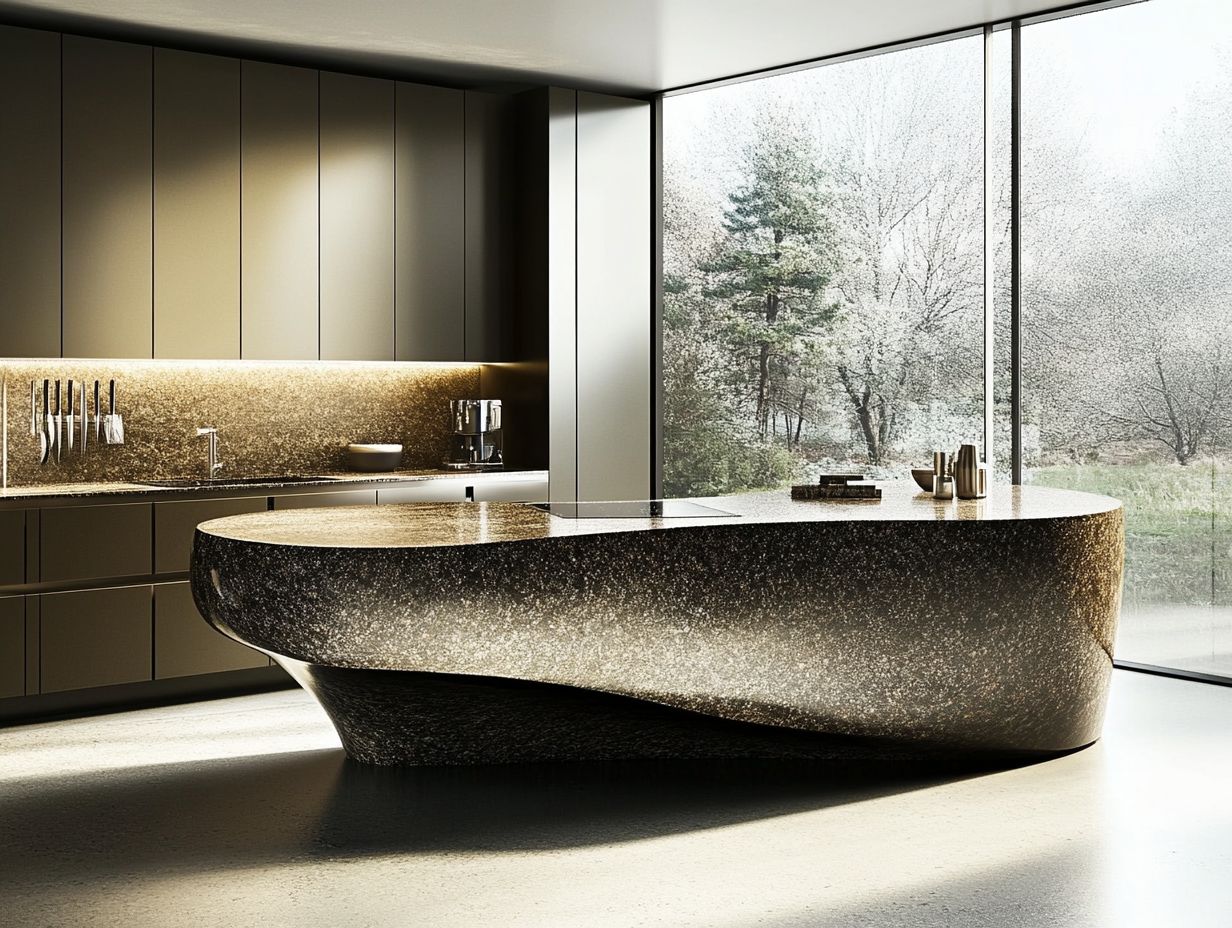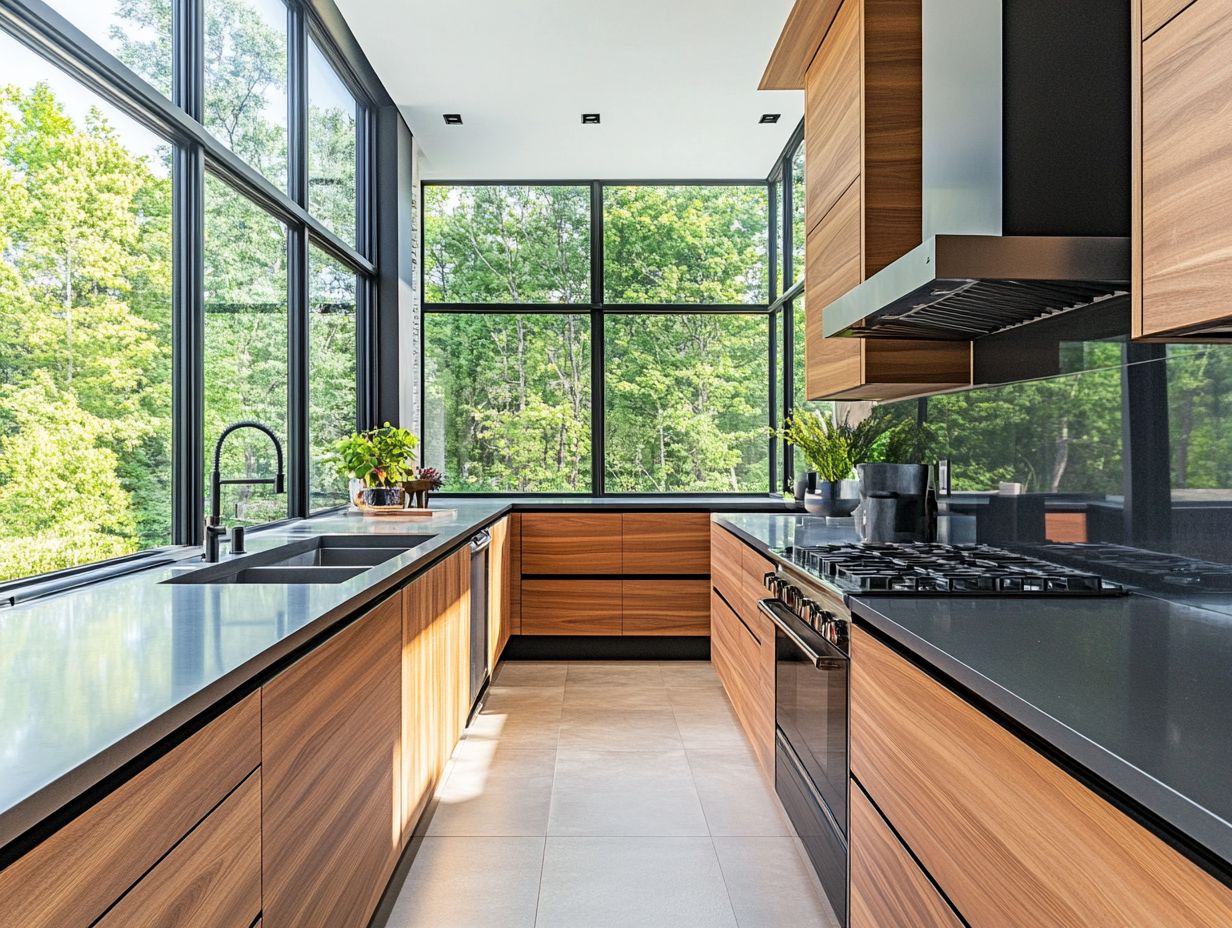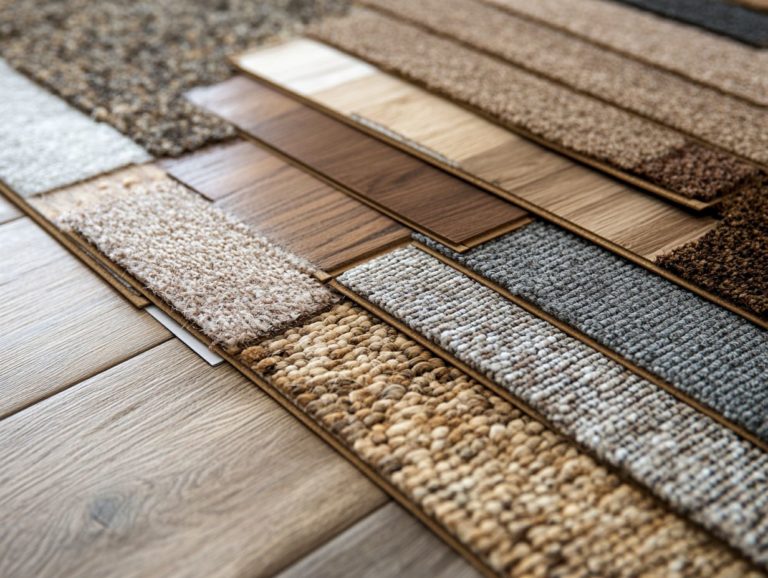The Benefits of Using Composite Materials in Kitchens
Composite materials are redefining kitchen design by seamlessly merging aesthetics with durability and functionality. This article explores the many advantages of incorporating composites into your kitchen space, focusing on their impressive longevity, moisture resistance, and design flexibility.
You will discover the various types of composite materials available, along with guidance on installation, maintenance, and essential cost considerations. These innovative materials can elevate your kitchen experience to a whole new level!
Contents
- Key Takeaways:
- Advantages of Using Composite Materials in Kitchens
- Types of Composite Materials for Kitchens
- Installation and Maintenance of Composite Materials
- Proper Installation Techniques
- Tips for Maintenance and Care
- Cost Considerations for Composite Materials in Kitchens
- Frequently Asked Questions
- What are the advantages of using composite materials in kitchens?
- Which types of composite materials are commonly used in kitchens?
- How does using composite materials benefit the environment?
- Are composite materials easy to install in kitchens?
- What makes composite materials a suitable choice for kitchen countertops?
- Do composite materials require special maintenance in kitchens?
Key Takeaways:

- Composite materials are durable and long-lasting choices for kitchen surfaces.
- They resist moisture and stains effectively.
- Composite materials offer flexibility in design options.
- Proper installation and maintenance techniques are crucial for optimal performance.
- While the initial cost may be higher, the long-term savings in durability and maintenance make them cost-effective.
What are Composite Materials?
Composite materials, such as composite stone, engineered worktops, and quartz, are remarkable innovations created from a blend of two or more distinct substances. They provide exceptional properties like durability, aesthetic beauty, and environmental sustainability.
Kitchens benefit from composite stone for its versatile applications and outstanding performance. This material, made from a blend of resins and stone particles, has impressive resistance to scratches and stains, making it an excellent choice for countertops and sinks.
Unlike traditional materials like granite, which often require periodic sealing, composite stone offers a low-maintenance solution while still being visually appealing. Compared to quartz, another popular option, composite stone typically presents a broader array of colors and patterns, allowing you to customize your kitchen to reflect your personal style without sacrificing quality.
Advantages of Using Composite Materials in Kitchens
The advantages of utilizing composite materials in kitchens are remarkable. They offer durability, low maintenance, and striking aesthetic appeal, making them an exceptional choice for modern kitchen designs.
Homeowners and designers are increasingly embracing these innovative materials, enhancing their kitchen spaces while ensuring top-notch functionality.
Durability and Longevity
Durability and longevity truly shine when it comes to composite materials, especially for kitchen countertops. These materials exhibit exceptional heat and stain resistance, making them perfectly suited for busy kitchen environments.
Take quartz surfaces, for example: they can withstand temperatures of up to 150 degrees Celsius, far exceeding traditional solid wood, which can easily succumb to burns and warping.
When it comes to oil, red wine, or coffee stains, composite surfaces clean effortlessly, unlike granite, which may absorb liquids if not sealed properly. This built-in resilience provides peace of mind for homeowners.
Choosing composite materials means investing in surfaces that maintain their beauty over time, minimizing the need for frequent replacements or repairs. In the long run, this not only saves you money but also conserves valuable resources.
Design Flexibility
One of the most compelling advantages of composite materials in your kitchen is their remarkable design flexibility. You have the freedom to choose from an extensive palette of colors, textures, and finishes, elevating the overall aesthetic appeal of your space.
This versatility truly shines when you’re considering custom kitchen solutions. Brands like Caesarstone and Silestone present an impressive selection that caters to a variety of design preferences. For example, you might opt for Caesarstone’s polished surfaces to achieve that sleek, modern vibe, or lean toward Silestone’s matte finishes for a more rustic, inviting atmosphere.
Incorporating these different finishes into your kitchen cabinets and countertops not only adds visual interest but also enhances practicality. Many of these materials boast resistance to stains and scratches.
By harnessing the unique properties of composite materials, you can craft a personalized kitchen that reflects your style while improving functionality. Transform your kitchen today, and experience the stunning difference composite materials can make!
Resistance to Moisture and Stains

The resistance to moisture and stains is a key feature of composite materials, especially when it comes to kitchen countertops. Their non-porous nature drastically reduces your maintenance time while enhancing overall hygiene.
This feature is crucial in areas where you prepare food, where spills and splatters are simply part of the process. Unlike traditional surfaces that often demand regular sealing or specialized cleaning to avoid absorption and staining, man-made surfaces designed for durability make upkeep a breeze.
Their smooth surfaces actively inhibit the growth of bacteria and other pathogens, making them a safer option for families. With the ease of cleaning, keeping your kitchen pristine becomes less of a chore, allowing you to immerse yourself in culinary creativity rather than getting bogged down by constant scrubbing and concerns about wear and tear.
Types of Composite Materials for Kitchens
When considering composite materials for your kitchen, you’ll find a variety of options at your disposal, such as engineered worktops, quartz worktops, and resilient composite wood. Each of these materials presents distinct advantages, allowing you to choose the perfect fit for your design aesthetic and functional requirements.
Comparison of Different Materials
When you compare different materials like man-made stone, granite countertops, and quartz, you’ll notice significant differences in price versus quality that can heavily influence your decision in selecting the best kitchen countertops.
Each option has its unique benefits and drawbacks that merit your attention. For instance, granite offers stunning natural beauty and remarkable durability, which appeals to those who value traditional aesthetics. However, you’ll need to seal it regularly to maintain its integrity.
On the flip side, quartz—being a man-made surface—provides consistency in patterns and colors and is more resistant to stains and scratches, but it often comes with a higher price tag for top brands. Man-made stone presents a budget-friendly alternative, striking a balance between affordability and resilience, though it may lack the same luxury feel as its competitors.
As you navigate these choices, understanding the market positioning of leading brands becomes crucial. They highlight the strengths and weaknesses of each material, enabling you to weigh your options effectively and make an informed decision.
Installation and Maintenance of Composite Materials
The installation of composite materials is remarkably straightforward, demanding minimal effort on your part. This simplicity makes them a highly appealing option for homeowners who desire an easy-to-maintain kitchen, particularly when it comes to incorporating composite sinks and countertops.
Maintenance is also uncomplicated, allowing you to enjoy your kitchen without the hassle of constant upkeep.
Proper Installation Techniques
Proper installation techniques are essential for ensuring the longevity and performance of composite materials, especially for engineered worktops and kitchen cabinets. You need precision and expertise to avoid common pitfalls.
Having a thorough understanding of the specific tools—like a circular saw for straight cuts and a router for smooth edges—can make a significant difference in your results.
Incorporating dry fitting before the final installation allows for necessary adjustments, ensuring a seamless integration with your kitchen structures. Attention to detail is key; even slight misalignments can affect both functionality and appearance.
Hiring professionals ensures optimal results and minimizes the risks associated with do-it-yourself attempts, ultimately protecting your investment.
Tips for Maintenance and Care

To extend the lifespan of composite materials in your kitchen, proper maintenance and care are crucial. This approach offers a low-maintenance option and supports environmental sustainability while delivering great performance.
By using simple cleaning methods and effective protective measures, along with a routine care regimen, you can keep these materials looking their best for years.
Regularly wiping surfaces with mild detergent and warm water not only gets rid of daily grime but also prevents stains, enhancing their overall appearance. Applying a sealant adds extra protection against spills and scratches, further extending the materials’ durability.
By following these practical tips, you can ensure your kitchen retains its functionality and charm, even amid the hustle and bustle of daily cooking and entertaining.
Cost Considerations for Composite Materials in Kitchens
When evaluating cost considerations for composite materials in your kitchen, it’s important to balance price and quality to get the best deal!
Ensure that your investment leads to long-term savings and value, while retaining the features that enhance your space.
Factors Affecting Cost
Many factors influence the cost of composite materials, and you should consider them when making your investment.
The quality of the materials, the brand reputation, and the complexity of installation requirements all play important roles in determining the final price.
The type of composite you choose—wood-plastic, fiberglass, or carbon fiber—can significantly impact pricing. Each option has unique characteristics tailored to different applications, affecting both demand and price.
Be aware that the availability of materials can fluctuate due to market demand or supply chain issues, leading to varying costs.
When comparing brands, established companies often command a premium for their products, backed by warranties and proven performance. In contrast, newer entrants may offer competitive prices to attract customers.
Understanding these factors enables you to make informed decisions that best align with your budget and project needs.
Long-Term Savings
Investing in composite materials can lead to substantial long-term savings. Their remarkable durability and low maintenance requirements significantly reduce the need for costly repairs and replacements.
This financial benefit becomes clear when you compare composite options to traditional materials like solid wood or granite, which often require regular upkeep, such as refinishing or sealing.
For example, you might spend hundreds each year on wood treatments or granite sealing, while composite materials generally need only occasional cleaning to maintain their like-new look.
Take composite decking, for instance; its resistance to rot and fading could save you thousands in potential repair costs, making a strong case for choosing composites in your construction and renovation projects.
Frequently Asked Questions
If you have any questions about composite materials or their installation, feel free to reach out or explore more resources. Don’t wait! Start enjoying the benefits of composite materials today!
What are the advantages of using composite materials in kitchens?

Composite materials offer durability, versatility, and low maintenance. These features make them a fantastic choice for any kitchen.
Which types of composite materials are commonly used in kitchens?
Common composite materials in kitchens include quartz, granite, marble, and acrylic solid surfaces. Each of these options provides unique benefits.
How does using composite materials benefit the environment?
Many composite materials are made from recycled materials, which makes them an eco-friendly option. Choosing these materials helps reduce waste.
Are composite materials easy to install in kitchens?
Yes! Composite materials are generally easy to install. This feature saves both time and money compared to natural stone materials.
What makes composite materials a suitable choice for kitchen countertops?
Composite materials won’t absorb liquids, so they resist stains and bacteria growth. This quality makes them perfect for kitchen countertops.
Do composite materials require special maintenance in kitchens?
No special maintenance is needed! Composite materials can be easily cleaned with everyday kitchen cleaners and don’t need sealing or refinishing like natural stone.





